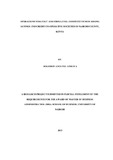| dc.description.abstract | As organizations are forced to respond effectively and efficiently to changing business
environment, then the big challenge that may face them is gaining and developing the
competitive advantage. Operations strategies lie at the core of developing and
maintaining competitive advantage. The aim of the study was to determine the
relationship between operations strategy and firm-level competitiveness. A survey design
was used in the study. Self-administered questionnaires were used to collect data from a
sample of 86 respondents drawn from 43 SACCOs in Nairobi County. Data was analyzed
using IBM SPSS 21. Descriptive statistics were used to determine the frequency of
responses, while bivariate correlations were used to determine the relationship between
operations strategy (conformance quality, cost efficiency, delivery dependability, flexible
responsiveness, new product development, new product introduction) and firm-level
competitiveness (quality, cost, delivery, flexibility). The descriptive statistics show that
Majority of the SACCOs had implemented the operations strategies and that over the
2010-2012 period, Majority of the SACCOs had introduced new products/services,
logistics/delivery/and distribution methods, as well as supporting activities for processes,
such as maintenance systems or operations, accounting, or computing. Bivariate
correlations showed that conformance quality (CQ); as an operations strategy developed
and implemented by SACCOs, has a positive and significant correlation with quality. CQ
is also positively but insignificantly correlated with cost, delivery and flexibility. Cost
efficiency (CE) is positively and significantly correlated with quality and flexibility. The
correlation with cost and delivery is not significant. Delivery dependability (DD) is
positively and significantly correlated with flexibility, but relationships with quality, cost,
and delivery are not significant. Finally, flexible responsiveness (FR) is positively and
significantly correlated with quality and flexibility, but correlation with cost and delivery
are not significant. These results show that quality and flexibility are therefore central to
achieving competitive advantage. By developing and implementing various operations
strategies, SACCOs have been able to achieve consistent growth, defend their market
share, and continue to develop their competitive advantage. In the end they are able to
maintain profitability and operational efficiency. The success of SACCOs in Nairobi,
with regard to the positive link between operations strategy and competitiveness, offers a
learning experience for other SACCOs in the country. | en_US |


